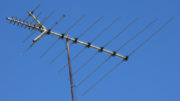If you’re in an older home, you’ve probably seen flat cable like this coming from your antenna. It was the standard for antenna cables until the mid-1970s when the familiar coaxial cable took over. Coaxial cables have better shielding but they’re more expensive to make and until cable TV came in, the demand for them in homes was fairly low.
Should you replace it?
If you have this kind of cable in your attic or connected to an older antenna, it’s got to be fairly old. If it works for you, if you’re getting the TV reception you want, then it’s probably not worth replacing. 300-ohm cable, which is what’s pictured above, actually matches the impedance of your antenna better than coaxial cable. It also has a better loss characteristic than coaxial cable. According to this 1965 article (roughly the last time anyone installed this sort of cable) 300-ohm cable loses about 1.7dB per 100 feet for high-VHF frequencies. Today’s RG6 cable loses about 3.2dB per 100 feet for the same frequencies. If the cable isn’t giving you any trouble, it might not be worth messing with it.
Why you might need to
However, the odds are that any cable that’s been exposed to sun is getting pretty corroded and if the bare copper is visible anywhere it’s probably turned very green by now and isn’t much good.
Not only that, but today’s broadcast landscape includes things that weren’t even dreamt of in 1965. There’s cellular data, Wi-Fi, microwave ovens, cordless phones (if you still have a landline) and Bluetooth. Coaxial cable offers better shielding and that may just be worth the little extra loss you incur by using it.
How to replace old flat cable
Rewiring should be a breeze with any RG-59 or RG-6 cable available at Solid Signal. At the antenna site, you’ll need a matching transformer that’s outdoor rated at the point where the 300 ohm cable formerly connected to the cable, and after that you can run that coaxial cable as far as you need. If you exceed 300 feet with an antenna or if you are using splitters, you may want to use an amplifier.
Chances are, you’re using a transformer somewhere down the line to convert that signal to 75 Ohm coax since it’s pretty rare to find a TV with 300 Ohm inputs anymore. You might remember that TVs used to have a pair of flathead screw terminals for antenna inputs, but it’s been about 30 years since you’ve seen that commonly used.
The bottom line here
If you’re not having trouble right now, you might ask yourself if it’s really worth it to rewire everything. It’s possible it isn’t, but that really depends on how important that antenna signal is to you. If you really depend on it, then it’s worth taking care of. Trust me, the one thing that is for certain is that cable isn’t going to get any better. It’s only going to keep corroding and keep making your reception worse. Sometimes it’s just better to replace things on your schedule rather than waiting for them to break.





